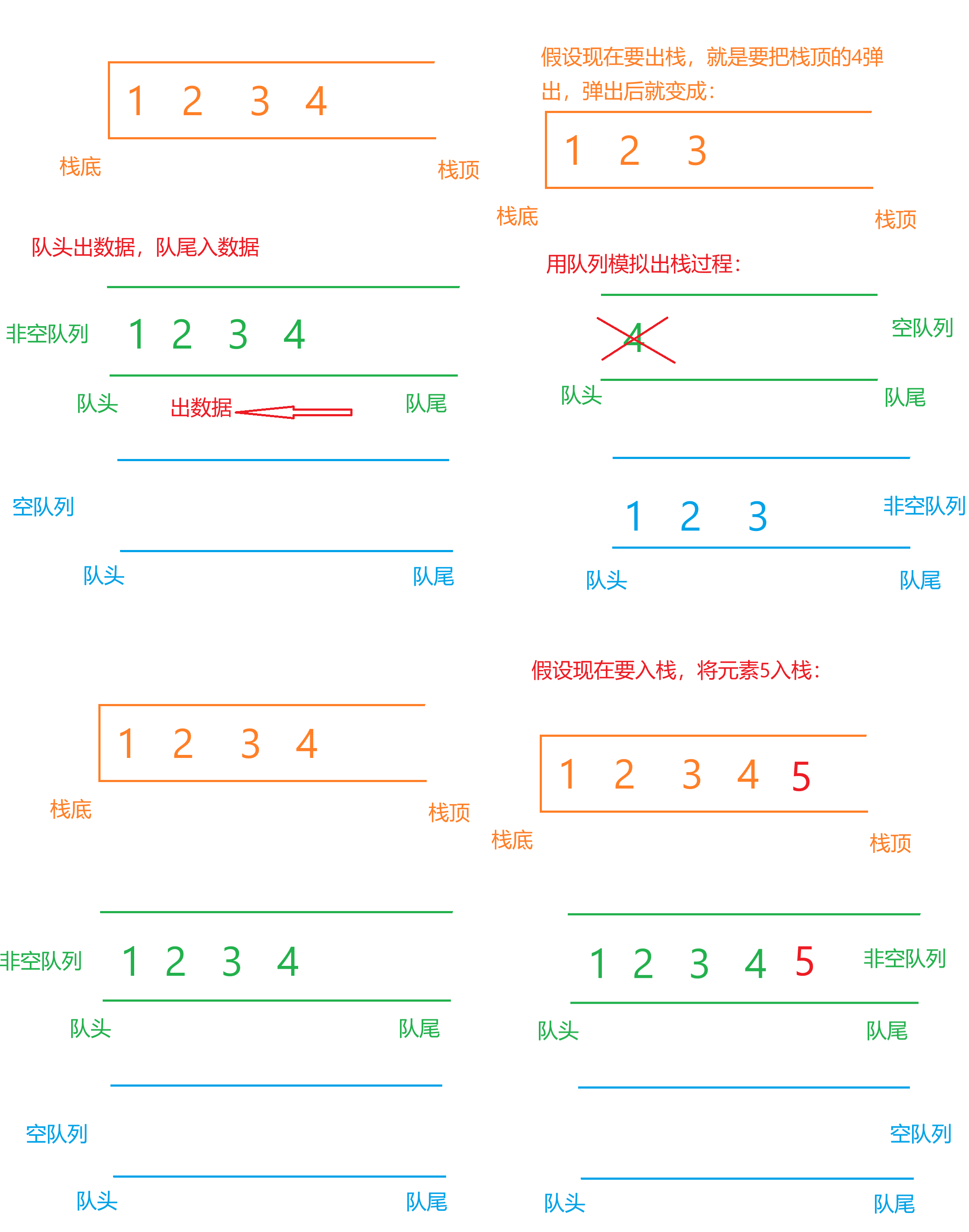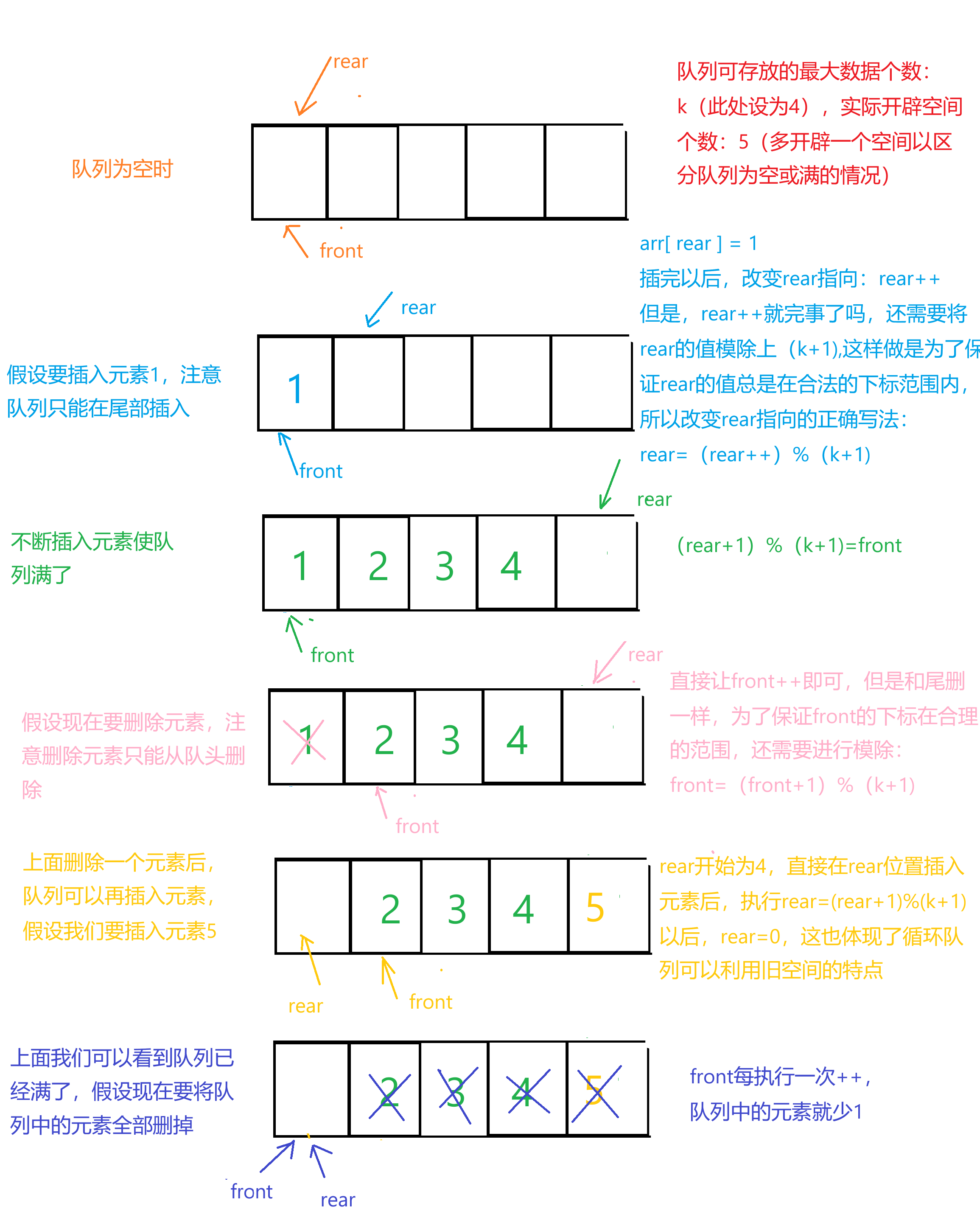225. 用队列实现栈 - 力扣(LeetCode)

这一题需要我们充分理解队列和栈的特点。
队列:队头出数据,队尾入数据。
栈:栈顶出数据和入数据。
我们可以用两个队列实现栈,在这过程中,我们总要保持其中一个队列为空。如果我们出栈,也就是要将栈顶元素弹出,就相当于对非空队列进行操作,就是要把非空队列的队尾元素弹出队列。但是队列的队尾是不能出数据的,想要让队尾数据出队列,就要让这个数据到达队头,同时我们还要保留其他的数据,就需要用到另一个队列来保存。
所以说,我们要用队列模拟出栈过程,就要把非空队列中的数据不断弹出放到另一个队列中,直到非空队列中的数据个数变成1,保留下这个数据的值,再将这个数据从队列中弹出。
对于取栈顶元素过程,大部分代码可以复用出栈的代码。或者我们可以发现栈顶元素就是非空队列的队尾元素,我们直接取出非空队列的队尾元素即可。
对于入栈过程,对于栈,我们直接将数据放到非空队列的队尾即可。
typedef int Qdatatype;
typedef struct QueueNode
{
Qdatatype data;
struct QueueNode* next;
}QueueNode;
//队列的结构定义:
typedef struct Queue
{
QueueNode* phead;//队头
QueueNode* ptail;//队尾
int size;//队列中有效数据个数
}Queue;
//初始化
void QueueInit(Queue* pq)
{
assert(pq);
pq->phead = pq->ptail = NULL;
pq->size = 0;
}
//销毁
void QueueDesTroy(Queue* pq)
{
QueueNode* pcur = pq->phead;
while (pcur)
{
QueueNode* pnext = pcur->next;
free(pcur);
pcur = pnext;
}
pq->phead = pq->ptail = NULL;
pq->size = 0;
}
//入队列
//入队列是在队尾入的,所以入队列相当于链表的尾插
void QueuePush(Queue* pq, Qdatatype x)
{
assert(pq);
//申请新的节点空间
QueueNode* newnode = (QueueNode*)malloc(sizeof(QueueNode));
newnode->next = NULL;
newnode->data = x;
//尾插
//如果此时队列中一个元素都没有
if (pq->phead == NULL)
{
pq->phead = pq->ptail = newnode;
}
else//队列本来就有元素
{
pq->ptail->next = newnode;
pq->ptail = newnode;
}
(pq->size)++;
}
//判空
bool QueueEmpty(Queue* pq)
{
assert(pq);
return pq->size == 0;
}
//出队列
//出队列是在队头出的,相当于链表的头删
void QueuePop(Queue* pq)
{
assert(pq);
assert(!QueueEmpty(pq));
//如果链表中只有一个元素
if (pq->phead->next == NULL)
{
free(pq->phead);
pq->phead = pq->ptail = NULL;
}
else//直接头删
{
QueueNode* newhead = pq->phead->next;
free(pq->phead);
pq->phead = newhead;
}
(pq->size)--;
}
//取队头数据
Qdatatype QueueFront(Queue* pq)
{
assert(pq);
assert(!QueueEmpty(pq));
return pq->phead->data;
}
//取队尾数据
Qdatatype QueueBack(Queue* pq)
{
assert(pq);
assert(!QueueEmpty(pq));
return pq->ptail->data;
}
//队列有效元素个数
int QueueSize(Queue* pq)
{
assert(pq);
return pq->size;
}
//=========前面为队列的实现===========
//栈的结构
typedef struct
{
Queue q1;
Queue q2;
} MyStack;
//栈的初始化
MyStack* myStackCreate() {
MyStack* stack=(MyStack*)malloc(sizeof(MyStack));
QueueInit(&(stack->q1));
QueueInit(&(stack->q2));
return stack;
}
//入栈
void myStackPush(MyStack* obj, int x)
{
Queue* empty=&(obj->q1);
Queue* nonempty=&(obj->q2);
if(QueueEmpty(&(obj->q2)))
{
empty=&(obj->q2);
nonempty=&(obj->q1);
}
QueuePush(nonempty,x);
}
//出栈
int myStackPop(MyStack* obj)
{
Queue* empty=&(obj->q1);
Queue* nonempty=&(obj->q2);
if(QueueEmpty(&(obj->q2)))
{
empty=&(obj->q2);
nonempty=&(obj->q1);
}
while(QueueSize(nonempty)!=1)//让非空队列中的元素不停地出栈直到栈中只有一个元素
{
//将元素放到原来是空的队列中
QueuePush(empty,QueueFront(nonempty));
//出队列
QueuePop(nonempty);
}
int ret=QueueFront(nonempty);
QueuePop(nonempty);
return ret;
}
//取栈顶元素:两种方法
//方法一:
int myStackTop(MyStack* obj)
{
Queue* empty=&(obj->q1);
Queue* nonempty=&(obj->q2);
if(QueueEmpty(&(obj->q2)))
{
empty=&(obj->q2);
nonempty=&(obj->q1);
}
while(QueueSize(nonempty)!=1)//让非空队列中的元素不停地出栈直到栈中只有一个元素
{
//将元素放到原来是空的队列中
QueuePush(empty,QueueFront(nonempty));
//出队列
QueuePop(nonempty);
}
int ret=QueueFront(nonempty);
QueuePush(empty,ret);
QueuePop(nonempty);
return ret;
}
//方法二:
int myStackTop(MyStack* obj)
{
Queue* empty=&(obj->q1);
Queue* nonempty=&(obj->q2);
if(QueueEmpty(&(obj->q2)))
{
empty=&(obj->q2);
nonempty=&(obj->q1);
}
return QueueBack(nonempty);
}
//判断栈是否为空
bool myStackEmpty(MyStack* obj) {
return QueueEmpty(&(obj->q1)) && QueueEmpty(&(obj->q2));
}
//销毁
void myStackFree(MyStack* obj)
{
QueueDesTroy(&(obj->q1));
QueueDesTroy(&(obj->q2));
free(obj);
obj=NULL;
}232. 用栈实现队列 - 力扣(LeetCode)
我们是可以用两个栈实现队列的结构的。具体实现方法如下:
我们定义两个栈,一个栈A是专门用来插入数据的,另一个栈B是专门用来出数据的。当我们要插入数据的时候,直接往A中插入即可,当我们要删除数据的时候,要先检查B是否为空,如果B为空,就讲A中的数据全部放入B中,如果B不为空,就直接对B进行出栈操作。
typedef int stdatatype;
//定义栈的结构:
typedef struct Stack
{
stdatatype* arr;
int top;//指向栈顶的后一个位置,也可以表示有效数据个数
int capacity;//栈中的最大容量
}ST;
//初始化
void STInit(ST* ps)
{
assert(ps);//防止后续空指针解引用
ps->arr = NULL;
ps->top = 0;//如果使top=0,那么top指向栈顶元素的后一个位置,
//如果想让top指向栈顶元素,就要让top初始化为-1
ps->capacity = 0;
}
//销毁
void STDesTroy(ST* ps)
{
assert(ps);
free(ps->arr);
ps->arr = NULL;
ps->capacity = ps->top = 0;
}
//入栈——栈顶
void STPush(ST* ps, stdatatype x)
{
assert(ps);
//先判断是否需要扩容
if (ps->top == ps->capacity)
{
//需要扩容
int newcapacity = ps->capacity > 0 ? 2 * ps->capacity : 4;
stdatatype*tmp = (stdatatype*)realloc(ps->arr, newcapacity * sizeof(stdatatype));
ps->arr = tmp;
ps->capacity = newcapacity;
}
ps->arr[(ps->top)++] = x;
}
//栈是否为空
bool STEmpty(ST* ps)
{
assert(ps);
return ps->top == 0;
}
//出栈———栈顶
void STPop(ST* ps)
{
assert(ps);
//出栈之前先判空
assert(ps->top);
ps->top--;
}
//取栈顶元素
stdatatype STTop(ST* ps)
{
assert(ps);
//去栈顶元素之前先判空
assert(ps->top);
return ps->arr[ps->top - 1];
}
//获取栈中有效元素个数
int STSize(ST* ps)
{
assert(ps);
return ps->top;
}
//================以上全是栈的实现=============
typedef struct
{
ST pushst;
ST popst;
} MyQueue;
MyQueue* myQueueCreate()
{
MyQueue* obj=(MyQueue*)malloc(sizeof(MyQueue));
STInit(&(obj->pushst));
STInit(&(obj->popst));
return obj;
}
void myQueuePush(MyQueue* obj, int x)
{
STPush(&(obj->pushst),x);
}
int myQueuePop(MyQueue* obj)
{
if(!STEmpty(&(obj->popst)))
{
int ret=STTop(&(obj->popst));
STPop(&(obj->popst));
return ret;
}
else
{
while(!STEmpty(&(obj->pushst)))
{
STPush(&(obj->popst),STTop(&(obj->pushst)));
STPop(&(obj->pushst));
}
int ret=STTop(&(obj->popst));
STPop(&(obj->popst));
return ret;
}
}
int myQueuePeek(MyQueue* obj)
{
if(!STEmpty(&(obj->popst)))
{
int ret=STTop(&(obj->popst));
return ret;
}
else
{
while(!STEmpty(&(obj->pushst)))
{
STPush(&(obj->popst),STTop(&(obj->pushst)));
STPop(&(obj->pushst));
}
int ret=STTop(&(obj->popst));
return ret;
}
}
bool myQueueEmpty(MyQueue* obj)
{
return STEmpty(&(obj->pushst)) && STEmpty(&(obj->popst));
}
void myQueueFree(MyQueue* obj)
{
STDesTroy(&(obj->pushst));
STDesTroy(&(obj->popst));
free(obj);
}622. 设计循环队列 - 力扣(LeetCode)
//我们用数组的结构设计循环队列
//这一题要善于运用模除的运算从而达到利用旧空间的效果
typedef struct {
int front;
int rear;
int*arr;
int capacity;
} MyCircularQueue;
bool myCircularQueueIsEmpty(MyCircularQueue* obj)
{
return obj->rear==obj->front;
}
bool myCircularQueueIsFull(MyCircularQueue* obj)
{
return (obj->rear+1)%(obj->capacity)==obj->front;
}
MyCircularQueue* myCircularQueueCreate(int k)
{
MyCircularQueue*cirque=(MyCircularQueue*)malloc(sizeof(MyCircularQueue));
cirque -> front=0;//指向 队头元素(即下一个要出队的元素)。
cirque -> rear= 0;//rear指向的是队尾元素的下一个位置
cirque -> arr=(int*)malloc(sizeof(int)*(k+1));//多开辟一个空间以区分队列满和空的状态
cirque->capacity=k+1;
return cirque;
}
//尾插
bool myCircularQueueEnQueue(MyCircularQueue* obj, int value)
{
if(!myCircularQueueIsFull(obj))
{
obj->arr[(obj->rear)++]=value;
obj->rear=(obj->rear)%(obj->capacity);
return true;
}
return false;
}
//头删
bool myCircularQueueDeQueue(MyCircularQueue* obj)
{
if(myCircularQueueIsEmpty(obj))
{
return false;
}
obj->front= ( obj->front+1)%(obj->capacity);
return true;
}
int myCircularQueueFront(MyCircularQueue* obj)
{
if(myCircularQueueIsEmpty(obj))
{
return -1;
}
return obj->arr[obj->front];
}
int myCircularQueueRear(MyCircularQueue* obj)
{
if(myCircularQueueIsEmpty(obj))
{
return -1;
}
return obj->arr[(obj->rear-1+obj->capacity)%(obj->capacity)];
}
void myCircularQueueFree(MyCircularQueue* obj) {
free(obj->arr);
free(obj);
}解析:图中我们解释了如何插入和删除元素

设计循环双端队列
双端队列(Deque,Double-Ended Queue)是一种支持 队头(front)和队尾(rear)两端高效插入和删除 的数据结构。
上一题我们实现了循环队列的实现,有了上一题的基础,我们就能利用循环队列来实现双端队列:
//双端队列中:
//front 直接指向当前队头元素(即下一个从队头出队的元素)。
//rear 指向队尾的下一个空位(即下一个插入队尾的位置)。
//在队头插入数据时,要先改变front指向;同理,在队尾插入元素以后,要改变rear的指向
//然而,插入元素后不能同时让front和rear同时递增或同时递减
//我们就使在队头插入数据后,front--,队尾插入数据后rear++
typedef struct {
int front;
int rear;
int capacity;
int*arr;
} MyCircularDeque;
MyCircularDeque* myCircularDequeCreate(int k)
{
MyCircularDeque* obj=(MyCircularDeque*)malloc(sizeof(MyCircularDeque));
obj->front=obj->rear=0;
obj->arr=(int*)malloc(sizeof(int)*(k+1));
obj->capacity=k+1;
return obj;
}
bool myCircularDequeIsEmpty(MyCircularDeque* obj)
{
return obj->rear==obj->front;
}
bool myCircularDequeIsFull(MyCircularDeque* obj)
{
return (obj->rear+1)%(obj->capacity)==obj->front;
}
//头插
bool myCircularDequeInsertFront(MyCircularDeque* obj, int value)
{
if(myCircularDequeIsFull(obj))
{
return false;
}
//front指向的是队头元素,所以我们再进行头插时,需要先改变队头指向
obj->front=(obj->front-1+obj->capacity)%(obj->capacity);
obj->arr[obj->front]=value;
return true;
}
bool myCircularDequeInsertLast(MyCircularDeque* obj, int value)
{
if(myCircularDequeIsFull(obj))
{
return false;
}
obj->arr[obj->rear]=value;
//改变rear指向
obj->rear=(obj->rear+1)%(obj->capacity);
return true;
}
bool myCircularDequeDeleteFront(MyCircularDeque* obj)
{
if(myCircularDequeIsEmpty(obj))
{
return false;
}
//插入元素是让front--,那么删除元素就要让front++
obj->front=(obj->front+1)%(obj->capacity);
return true;
}
bool myCircularDequeDeleteLast(MyCircularDeque* obj)
{
if(myCircularDequeIsEmpty(obj))
{
return false;
}
obj->rear=(obj->rear-1+obj->capacity)%(obj->capacity);
return true;
}
int myCircularDequeGetFront(MyCircularDeque* obj)
{
if(myCircularDequeIsEmpty(obj))
{
return -1;
}
return obj->arr[obj->front];
}
int myCircularDequeGetRear(MyCircularDeque* obj)
{
if(myCircularDequeIsEmpty(obj))
{
return -1;
}
return obj->arr[(obj->rear-1+obj->capacity)%(obj->capacity)];
}
void myCircularDequeFree(MyCircularDeque* obj)
{
free(obj->arr);
obj->arr=NULL;
obj->front=obj->rear=obj->capacity=0;
free(obj);
obj=NULL;
}